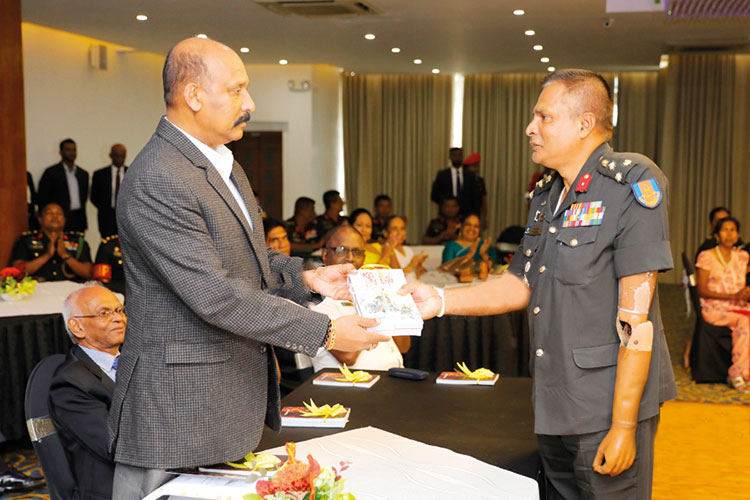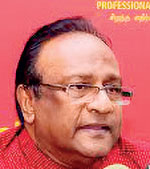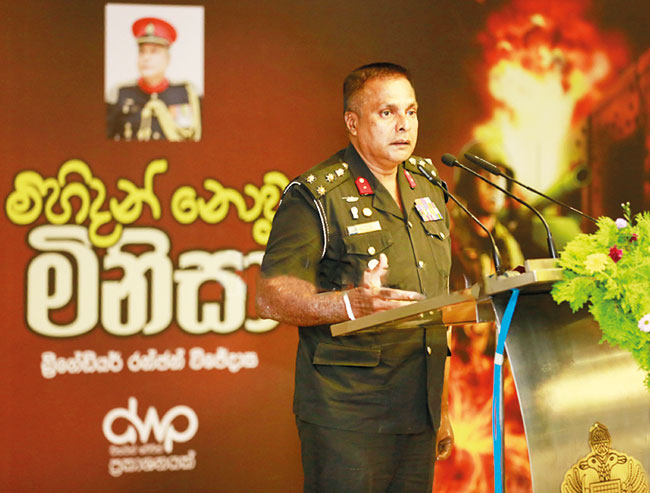SPECIAL REPORT : Part 492
Let us set the record straight, officially
Sarath Weerasekera
Retired Rear Admiral Sarath Weerasekera recently declared that in his capacity as Chairman of the Sectoral Oversight Committee on National Security he would present to President Ranil Wickremesinghe a comprehensive report on how the war was conducted.
The recent US denial of a visa to Adm. Weerasekera underlines the need to take tangible measures to safeguard the interests of serving and ex-military personnel, especially when being unfairly targeted by foreign entities with ulterior motives, like wanting to break up Sri Lanka in pursuit of their agendas.
The announcement was made at a media briefing held at the Presidential Media Centre (PMC). Sri Lanka needs to prepare an all-inclusive dossier on the war. Regardless of some retired/serving officers sharing their experience by way of books and social media, successive governments failed to compile a complete book on the conflict that didn’t belong to any service, a particular regiment or an individual.
The efforts made by individual officers to share their experience should be encouraged but the responsibility of the government is to produce an official record taking into consideration all factors.
It would be pertinent to mention that Sri Lanka is the only country on earth to betray her war-winning armed forces. The Geneva betrayal on 01 October, 2015, underscored the treachery on the part of the then shameless Yahapalana administration. Let there be a genuine effort to restore the pride of our armed forces who saved the country from anarchy in 1971, 1987-1990 and from separatist LTTE terrorism.
By Shamindra Ferdinando
Daredevil Armoured Corps officer Ranjan Wijedasa, 52, shared his battlefield experiences in Mihidan Nowu Minisa ( The man who did not get buried) launched in September this year, 15 years after the combined security forces brought the war against the Liberation Tigers of Tamil Eelam (LTTE) to a successful end. Sri Lanka proved that what had been termed an unwinnable war here and abroad could be won. The LTTE caught up in a multi-pronged offensive that involved several Divisions and Task Forces in the East and then Vanni theatre, lasting just two years and months.
The recent Hamas attack on Israel that involved groups of heavily armed men invading the Jewish state from the air, sea and ground while thousands of missiles fired from Gaza caused unprecedented death and destruction underscored Sri Lanka’s triumph over the LTTE though the circumstances cannot be compared. The Hamas offensive is a grim reminder how lapses on the part of the political-military setup could cause catastrophe of unprecedented proportions. Judging by international reportage of the latest Israel-Gaza war, there cannot be any dispute regarding the assertion that the Jewish state never expected Hamas to undertake such a large-scale offensive. In that background, let me discuss the Eelam war experienced by an officer who had served the Army at a time eradication of terrorism seemed impossible.
Thrice wounded Wijedasa, now a Brigadier, serving the National Defence College as the Senior Directing Staff, had to quit active service following the amputation of his left hand below the elbow in Aug., 1997 due to injuries suffered during offensive action at Puliyankulam. The young tank officer, in spite of being married to Ruchirani Siriwardena in May 1997, gladly joined the largest ever ground offensive Jayasikurui (Victory Assured) conducted before Eelam War IV (Aug 2006-May 2009). But, Jayasikurui meant to restore the Overland Main Supply Route (MSR) to the Jaffna peninsula had been nothing but a disaster that sent shockwaves through the then political establishment. That offensive should be examined against the backdrop of subsequent LTTE counter-offensive that at one-time threatened even Vavuniya, a strategically important town situated north of Anuradhapura.
Wijedasa had been on the staff of the then Director, Operations Brigadier Udaya Perera during Eelam War IV. One-time Sri Lanka Deputy High Commissioner in Malaysia (2009-2011) Perera, who retired in 2017, is on the US list of war criminals. That categorization has been made in Dec. 2021. Sri Lanka never made a genuine effort to counter unsubstantiated war crimes allegations, thereby facilitating the despicable Western agenda. It would be pertinent to mention that the treacherous UNP-SLFP Yahapalana administration shamelessly betrayed the war-winning military by sponsoring an accountability resolution against one’s own country because that impossible victory was attained against the LTTE by their political rival and to please the West, in early Oct. 2015 by co-sponsoring a US-led move, one of the world’s worst human rights offenders.
Let us get back to Wijedasa’s account of his fighting experience with the Armoured Corps (1991-1997) after having joined the Army in January 1990, several weeks before India pulled out her forces from the then temporarily-merged Northern and Eastern Province. The Eelam War II erupted in the second week of June 1990 while Wijedasa was undergoing training at the Diyatalawa Military Academy. Slain President Ranasinghe Premadasa allowed an LTTE build-up during a 14-month long ‘honeymoon’ with LTTE leader Velupillai Prabhakaran that paved the way for the group to exploit the ground situation. Their experience in fighting the Indian Army had been an added advantage against isolated detachments along the Kandy-Jaffna A9 road north of Vavuniya. The Army lost Thandikulam –Elephant Pass stretch within weeks after the resumption of hostilities in the second week of June 1990. The Army Commander ended up with egg on his face. Sandhurst trained Hamilton Wanasinghe was his name (Aug. 1988-Nov. 1991). Jayasikurui was meant to regain the MSR at any cost.
Devastating losses at Puliyankulam
- Brig. Ranjan Wijedasa addressing a gathering at Rock House Armoured Corps camp, Mattakkuliya, at the launch of his memoirs (pics courtesy MoD)
At the time Wijedasa suddenly received orders to take over the command of ‘Alpha’ squadron assigned for the Jayasikurui offensive, he was preparing to leave Vavuniya to receive an appointment at the Directorate of Personnel, Army headquarters. Without referring to the Divisions that had been involved in the disastrous bids to capture fiercely defended Puliyankulam, the author described the effort made by the Armoured Corps to bring the town under its control after assaults spearheaded by the infantry failed. The operation involved the 53 Division. It included elite formations with vast experience in fighting in both eastern and northern theatres but couldn’t overcome fierce resistance offered by the enemy or thwart a series of counter attacks which paralyzed fighting Divisions.
The author recalled the devastating outcome of the battle between the Armoured Corps and LTTE units armed with Rocket Propelled Grenades (RPGs) and the effective use of monster landmines capable of immobilizing a 40-tonne Main Battle Tank (MBT). Of the 48 tanks that had been assigned for the task, only three were able to penetrate enemy defences and reach Puliyankulam town. Each tank had been accompanied by three Armoured Fighting Vehicles (AFVs) but accurate RPG attacks on one of the AFVs and the author’s T-55 MBT forced the Armoured Corps to retreat. In hindsight, the Army, at that time, lacked sufficient fighting battalions to conduct large scale offensive operations and the strategy- opening a front with the objective of restoring the MSR seemed reckless at a time the enemy could move within the vast Vanni region without hindrance.
Within 24 hours after suffering injuries, Wijedasa had been transferred from the battlefield to Vavuniya in a Bell 212, then from there to Anuradhapura in Y12 fixed wing aircraft before being airlifted to the National Hospital, Colombo.
Jayasikurui launched in May, 1997 was meant to restore overland MSR to the Jaffna peninsula as the government found it extremely difficult to maintain the sea supply route from Trincomalee to Kankesanthurai. Perhaps, author Wijedasa should have dealt with the loss of MSR soon after the LTTE resumed hostilities in the second week of June 1990. Isolated detachments along the MSR north of Vavuniya were either destroyed or vacated by the Army in quick succession as President Premadasa quickly lost control of the war, having conspired with the LTTE to oust the Indian Army.
Regardless of heavy losses, the then President Chandrika Bandaranaike Kumaratunga, in her capacity as the Commander-in-Chief of armed forces pressed ahead with Jayasikurui. Finally, Kumaratunga called off the offensive in early Dec. 1998 after the Army acknowledged it couldn’t sustain the offensive any longer. Maj. Gen. Asoka Jayawardena, in his capacity as the Overall Operations Commander (OOC) commanded Jayasikurui. Instead, in a bid to divert public attention from the debacle, troops were deployed to capture Oddusuddan and annex the areas covering Mankulam, Oddusuddan and Nedunkerni in the Vanni east. That, too, ended with disastrous consequences. That offensive was called Rivi Bala.
By the time Mrs. Kumaratunga won a second term at the Dec. 1999 presidential election, the LTTE had the upper hand in the northern theatre of operations. The election was conducted following a series of severe battlefield defeats leading to the worst single ever debacle suffered by the Army in April 2000. The LTTE defeated the 54 Division plus troops deployed at Elephant Pass sector that encompassed Iyakachchi and Vettilaikerni on the Mullaitivu coast. Eventually, the then Lt. Gen. Fonseka’s Army restored overland MSR in January 2009 following major battlefield success both west and east of the Kandy-Jaffna A9 road.
The reportage was subjected to military censorship. The military resorted to harsh censorship to prevent the public from knowing the actual situation. Devastating losses suffered by Armoured Corps were not allowed to be reported in the print media at a time television didn’t cover the conflict and social media never heard of. The losses suffered by the Armoured Corps remained unreported until Brig. Wijedasa went public
The LTTE allowed Rivi Bala troops to advance. Prabhakaran refrained from resisting the latest offensive that involved the 53 and 55 Divisions and some elements of the 56 Division that had been previously involved in Operation Jayasikuru, to bring back Oddusuddan under government control, situated north of Nedunkerni, as it shifted focus of offensive action to east of the A9 road. The LTTE didn’t resist as troops secured Oddusuddan, situated 14 km north of Nedunkerni.
This writer had the opportunity to visit the new frontlines at Nedunkerni-Oddusuddan on Oct. 6, 1998, along with a group of journalists when Deputy Defence Minister Anuruddha Ratwatte visited the area. Having participated at a Hindu religious ceremony at Oddusuddan, Minister Ratwatte in camouflaged battle dress was about to get into a Russian built BTR 80 armoured personnel carrier when the LTTE fired four rounds of mortars at the group. At the time of the incident, the visiting group of journalists was about two kilometers south of the scene of the attack. My senior colleague from our sister paper Divaina Sirimevan Kasthuriarachchi was among the group. The group was being moved to Oddusuddan in locally built armoured personnel carriers when the LTTE fired mortars. The convoy stopped in the middle of the road leading to Oddusuddan when the SLA fired artillery in response to the LTTE attack. The group was stuck there for more than an hour. Although Minister Ratwatte, Army chief, Lt. Gen. Daluwatte, SLN Commander, Vice Admiral Cecil Tissera, Air Force Commander, Air Vice Marshal Jayalath Weerakkody and Wanni Security Forces Commander, Maj. Gen. Lionel Balagalle miraculously escaped, the LTTE attack claimed the lives of four SLA personnel, while 42 received injuries. Three bodyguards of Minister Ratwatte were among the wounded (Anuruddha and service chiefs in narrow escape––The Island Dec. 7, 1998).
A proud father’s advice
Ranjan’s father had served the Army and retired in the rank of Captain. Having studied at Isipathana College, Colombo, where he attended the primary, Ranjan and his three brothers – one elder to him and two younger – the family moved to Mahena, a village near Warakapola, after the retirement of Captain W.A. Wijedasa in 1979. The Brigadier’s narrative of their simple way of life and the boys’ escapades captured the readers’ interest. References were made to the retired officer being recalled in 1983 in the wake of July riots following the killing of 13 soldiers at Thinnaveli, Jaffna, and the emergence of the second JVP insurrection. The enjoyable time Ranjan and his elder brother had at Minneriya Infantry Training Centre and the opportunity granted to the boys to engage in exercises meant for soldiers perhaps influenced their decision to join the Army.
At the time, Ranjan had been chosen for the prestigious Diyatalawa Military Academy, his elder brother Manjula was there. The author’s description of nearly two yearlong training there made good reading but nothing could have been as important as advice he received from his father on the day he was commissioned as a Second Lieutenant of 33 Intake of SLMA. His brother, now retired after serving the military for nearly 20 years, too, had served the Armoured Corps though the two brothers were not assigned to the same unit during the conflict.
The author quoted his father as having told him that there were various funds in the Army. “Never touch those funds. If you need money, give me a call. Don’t smear insignia with faeces by stealing money.” Unfortunately, such high morals seemed to have made no impact on the overall public service, including the armed forces if allegations traded in Parliament and outside are true. The country is in dire straits due to waste, corruption, irregularities and mismanagement. With both the private and public sectors badly affected, the armed forces and police, too, deteriorated since the conclusion of the conflict in May 2009. Corruption takes a heavy toll on post-war bankrupt Sri Lanka with the economy in such a precarious state with many complaining the difficulties were worse than the time of conflict.
Fifteen years after the end of the conflict, the government is in the process of gradually reducing the Army’s strength to 135,000 by the end of next year and 100,000 by 2030. At the time a soldier shot Velupillai Prabhakaran through the head on the banks of the Nanthikadal lagoon on the morning of May 19, 2009, the Army strength stood at approximately 205,000. The gradual reduction commenced during Mahinda Rajapaksa’s tenure as the President. By the time, President Gotabaya Rajapaksa was forced out of office, the Army strength was down to approximately 168,000. The continuing economic crisis has compelled the Wickremesinghe-Rajapaksa government to go ahead with further downsizing of the Army and by next year the strength is expected to be down to 135,000 and 100,000 six years later.
It would be pertinent to mention that the war couldn’t have been won if not for President Mahinda Rajapaksa’s approval of Lt. Gen. Sarath Fonseka’s call for a larger Army. From some 116,000 officers and men, while the Army was fighting on multiple fronts over a period of three years, the strength was increased to 205,000, a tremendous achievement in an environment of instability, uncertainty and political turmoil.
Brig. Wijedasa paid a glowing tribute to Field Marshal Fonseka while recalling the Sinha Regiment hero’s declaration that he wouldn’t leave the war unfinished. Fonseka gave that assurance at a time the LTTE remained a formidable fighting force with conventional fighting capacity in land, sea and even in air with a rudimentary air force, which was used to bomb Colombo on at least two occasions.
DK visits Pooneryn
Brigadier Wijedasa disclosed a hitherto unheard visit by the then Northern Commander Maj. Gen. Denzil Kobbekaduwa to isolated Pooneryn-Nagathevanthurai military base at an early stage in the author’s career. Pooneryn-Nagathevabthurai had been perhaps one of the most difficult bases to serve during the war and was the scene of one of the fiercest attacks carried out by the LTTE on the Vanni east. The Army lost hundreds of men. Kobbekaduwa, also of the Armoured Corps during the visit to Pooneryn had declared that MBTs could operate anywhere in the Pooneryn sector whereas the author dared to disagree with the deployment of such heavy equipment in boggy conditions. Kobbekaduwa seemed to have been offended by the junior officer’s suggestion and ordered the author to prepare a MBT to move from Pooneryn to Kalmunai Point a distance of about 20 kms towards the Jaffna lagoon. Wijedasa recalled how he accompanied by Lt. Colonel Chitral Punchihewa, the Commanding Officer of the infantry deployed therein left Pooneryn atop T-55 MBT and after covering a distance of about 10 km was unexpectedly bogged down. The only other MBT that had been deployed at Pooneyn was called in to pull the bogged down T- 55. The rescuer, too, had got bogged down at the same location where those assigned for the two MBTs had to remain there for three weeks until a tank recovery vehicle was brought in from Mullaithivu by ship to Trincomalee and then overland to Pooneryn to pull the T 55s.
Regardless of orders issued by the Northern Commander in this regard, other officers senior to Wijedasa at that time had found fault with him for the fiasco. However, Lt. Col. Punchihewa had taken the responsibility for the incident thereby saved Wijedasa from being tainted. Wijedasa recollected Punchihewa’s sacrifice with love and gratitude while revealing the death of his savior in a landmine blast that ripped apart his Land rover speeding towards Kalmunai Point. What is really poignant in Punchihewa’s death is that the Lt. Col. had stopped on his way to Kalmunai Point after seeing Wijedasa at the helipad with another officer and inquired what they were doing in the hot sun. The incident underscored the senior officer’s humanitarian qualities amidst a brutal war.
Brigadier Wijedasa’s memoirs is a must read for those really interested in the conflict and how the military absorbed the youth. It would be the responsibility of the top brass to ensure the young officers and men learn from the past as it were. Wijedasa’s memoirs Mihidan Nowu Minisa can be purchased from Design Waves Private Ltd. Tel 011 2150 100 (www.designwaves.lk)



